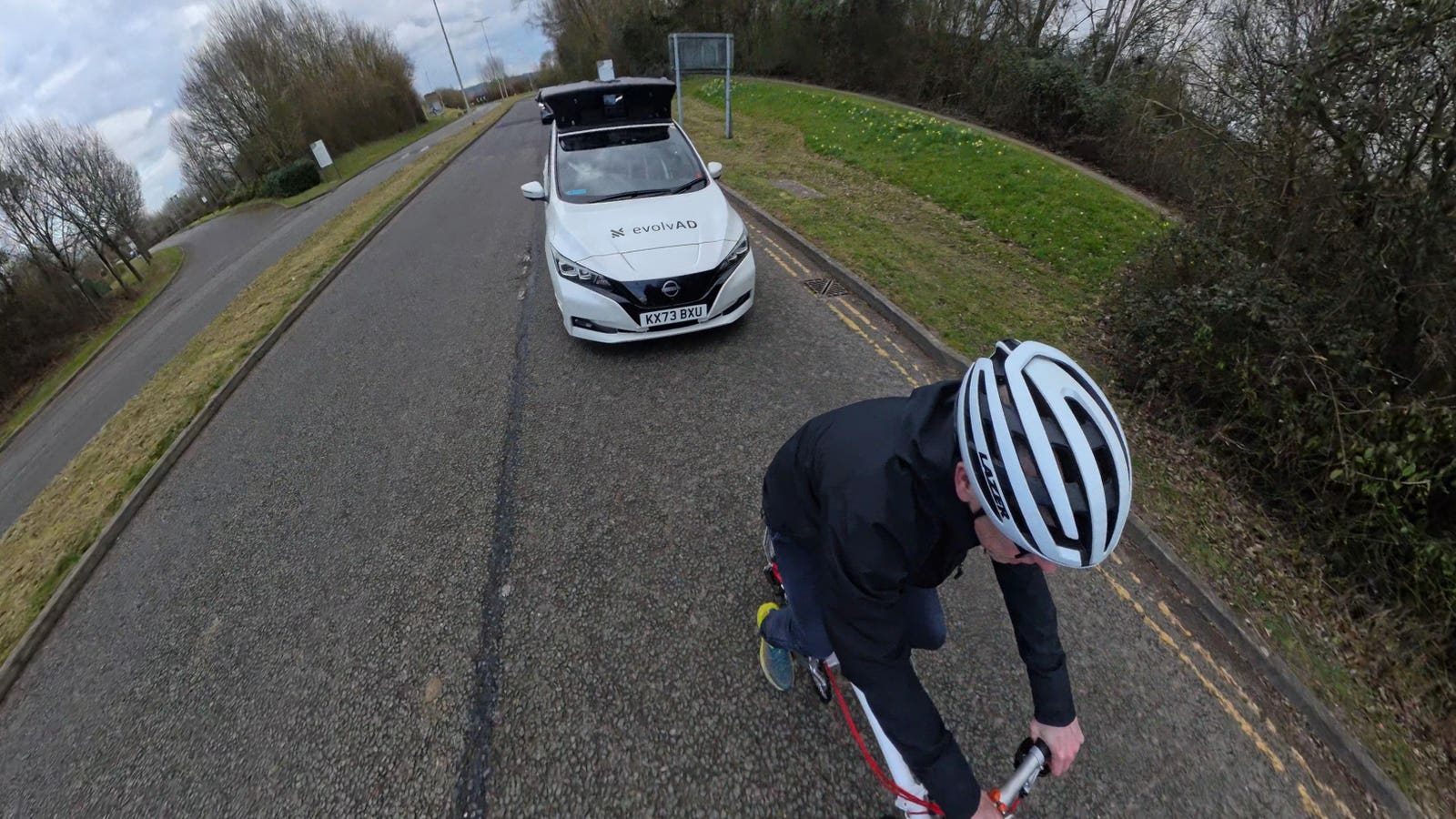Nissan driverless car slows behind Carlton Reid on a bicycle, near Cranfield, 50 miles north of … [+]
I deliberately cycled in front of an electric car today on a 60-mph road and didn’t die. The car behind was a Nissan Leaf decked out with fifteen cameras, four long-range lidar sensors, and two short-range ones, plus a radar behind the grille. This is Nissan’s evolvAD driverless car (the AD stands for “autonomous driving”) from the Japanese company, which has its European research and development center in Cranfield, fifty miles north of London. I was a guest of Nissan, which wanted to get journalists involved as this particular project officially ended.
The roads outside Nissan Technical Center Europe are a mix of rural and town roads, with potholes, blind corners, some narrow widths, and plenty of obstacles, including, today, me.
However, I was in safe hands. Sort of. This driverless car—like others being tested in the U.K.—has a safety driver who must keep his hands close to the steering wheel should he need to regain control. I’d already told the driver what I would do, so it was no surprise to him when I jammed on my brakes and forced the Leaf to slow to a crawl behind me. In 2017, a previous version of the car skimmed a cyclist in London, leading to some bad press, so this latest iteration has been programmed not to overtake cyclists, horse riders, or anything slow-moving on the road. Instead, the safety driver is now charged with regaining control and executing the overtake, adhering to the Highway Code by giving as much room as would be required to overtake a car. The evolvAD can overtake cyclists, but the decision was made not to allow the car to travel in the oncoming lane, where a Highway-Code-compliant driver would have to go.
I cannot tell a lie: it was fun to magically slow the car behind me, knowing it wouldn’t overtake. Behind the Nissan Leaf, a driver of an Audi was having none of this careful robot driving malarkey and overtook us both at speed and clearly with some frustration. Robot drivers are patient drivers and won’t flip the bird.
This doesn’t mean Nissan’s driverless car is a slouch. Stashing my bike, I also had a 20-minute trip in the sensor-heavy Leaf and can report—without pesky obstacles in front—it drives aggressively, accelerating swiftly to the 60 mph speed limit from 20 mph at roundabouts, hugging road edges and, with sensors in the wheels, sporting optimum road grip. Nissan says the evolvAD has been tuned to drive like a human, a human who has passed an advanced driving course.
EvolvAD builds on previous Nissan-backed projects in the U.K.—HumanDrive and ServCity—which, since 2016, have driven 16,000 autonomous miles across the country’s freeways, urban centers, residential streets, and countryside. There have been zero crashes.
The successful conclusion of evolvAD—a $4 million project—prepares for the next phase of autonomous driving, which will assess the readiness of cities and regions across the U.K. for the future introduction of AD systems and services.
Delivered by a consortium of five partners, including Nissan as technical lead, evolvAD was jointly funded by the U.K. government and the consortium partners, Connected Places Catapult, Humanising Autonomy, SBD Automotive, and TRL.
Carlton Reid’s Brompton folding bike next to a driverless driverless Nissan Leaf.
In addition to being driven on the rural roads around Cranfield, evolvAD cars were also tested on various roads in Greenwich, London, where the Smart Mobility Living Lab (SMLL) has placed dedicated CCTV cameras that fed live information to Nissan’s driverless cars. So, as well as huge amounts of data from the rooftop sensors, SMLL cameras also provided information on road conditions in advance of the car. In effect, the car could see around corners and, for instance, would change to another lane long before the reason for the lane change would be apparent to a human driver. This vehicle-to-infrastructure (V2I) could be essential for the roll-out of semi- and fully autonomous cars in cities, although who would pay for this infrastructure has yet to be decided.








